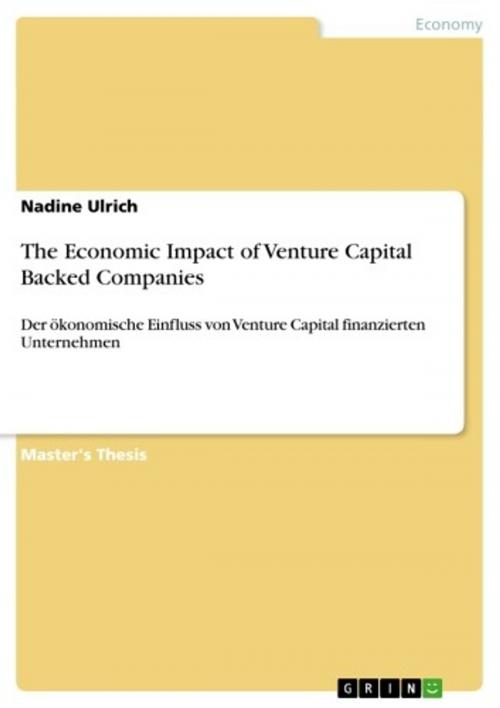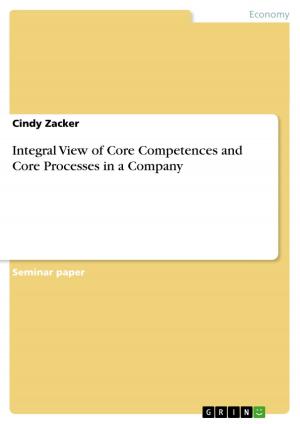The Economic Impact of Venture Capital Backed Companies
Der ökonomische Einfluss von Venture Capital finanzierten Unternehmen
Business & Finance, Finance & Investing, Finance| Author: | Nadine Ulrich | ISBN: | 9783640427802 |
| Publisher: | GRIN Publishing | Publication: | September 14, 2009 |
| Imprint: | GRIN Publishing | Language: | English |
| Author: | Nadine Ulrich |
| ISBN: | 9783640427802 |
| Publisher: | GRIN Publishing |
| Publication: | September 14, 2009 |
| Imprint: | GRIN Publishing |
| Language: | English |
Master's Thesis from the year 2007 in the subject Business economics - Investment and Finance, grade: 1,3, Technical University of Munich (Lehrstuhl für Entrepreneurial Finance), language: English, abstract: Die Arbeit beschäftigt sich mit dem ökonomischen Einfluss von Venture Capital-finanzierten Unternehmen und betrachtet dabei im Detail drei Bereiche: Wachstum, Beschäftigung und Innovationen. Outline of the work The objective of this paper is the investigation of the economic impact of venture capital-backed companies. Therefore growth, employment and innovation are examined as the three most important spheres of influence. Beyond that, venture capital probably affects further areas of economy that are however not described within the scope of this work. This analysis should clarify the extent and kind of influence of venture-backed enterprises. It is based on various studies about the economic impact of venture capital, covering different research methods and geographic regions all over the world. The structure of the paper is shown in Fig. 1. The first chapter introduces the topic by describing the relevance of the subject and the structure of the work. Thereafter follows a definition of venture capital, a specification of the economic focus and a discussion of methodological issues. The chapters three to five constitute the main part and investigate the above-mentioned spheres, applying a three-staged examination method. The first section describes the respective topic and discusses relevant measures for the analysis. The second section inspects the development of venture capital-backed companies by looking at quantitative and qualitative aspects. The measures identified in the first section are chosen as quantitative indicators. The qualitative research focuses on the strongest influenced areas. The last section of the respective chapter assesses the economic importance of the topic, summarises the findings and determines the role of venture capitalists. Chapter six closes with a summary of the most important results and a further outlook.
Master's Thesis from the year 2007 in the subject Business economics - Investment and Finance, grade: 1,3, Technical University of Munich (Lehrstuhl für Entrepreneurial Finance), language: English, abstract: Die Arbeit beschäftigt sich mit dem ökonomischen Einfluss von Venture Capital-finanzierten Unternehmen und betrachtet dabei im Detail drei Bereiche: Wachstum, Beschäftigung und Innovationen. Outline of the work The objective of this paper is the investigation of the economic impact of venture capital-backed companies. Therefore growth, employment and innovation are examined as the three most important spheres of influence. Beyond that, venture capital probably affects further areas of economy that are however not described within the scope of this work. This analysis should clarify the extent and kind of influence of venture-backed enterprises. It is based on various studies about the economic impact of venture capital, covering different research methods and geographic regions all over the world. The structure of the paper is shown in Fig. 1. The first chapter introduces the topic by describing the relevance of the subject and the structure of the work. Thereafter follows a definition of venture capital, a specification of the economic focus and a discussion of methodological issues. The chapters three to five constitute the main part and investigate the above-mentioned spheres, applying a three-staged examination method. The first section describes the respective topic and discusses relevant measures for the analysis. The second section inspects the development of venture capital-backed companies by looking at quantitative and qualitative aspects. The measures identified in the first section are chosen as quantitative indicators. The qualitative research focuses on the strongest influenced areas. The last section of the respective chapter assesses the economic importance of the topic, summarises the findings and determines the role of venture capitalists. Chapter six closes with a summary of the most important results and a further outlook.















